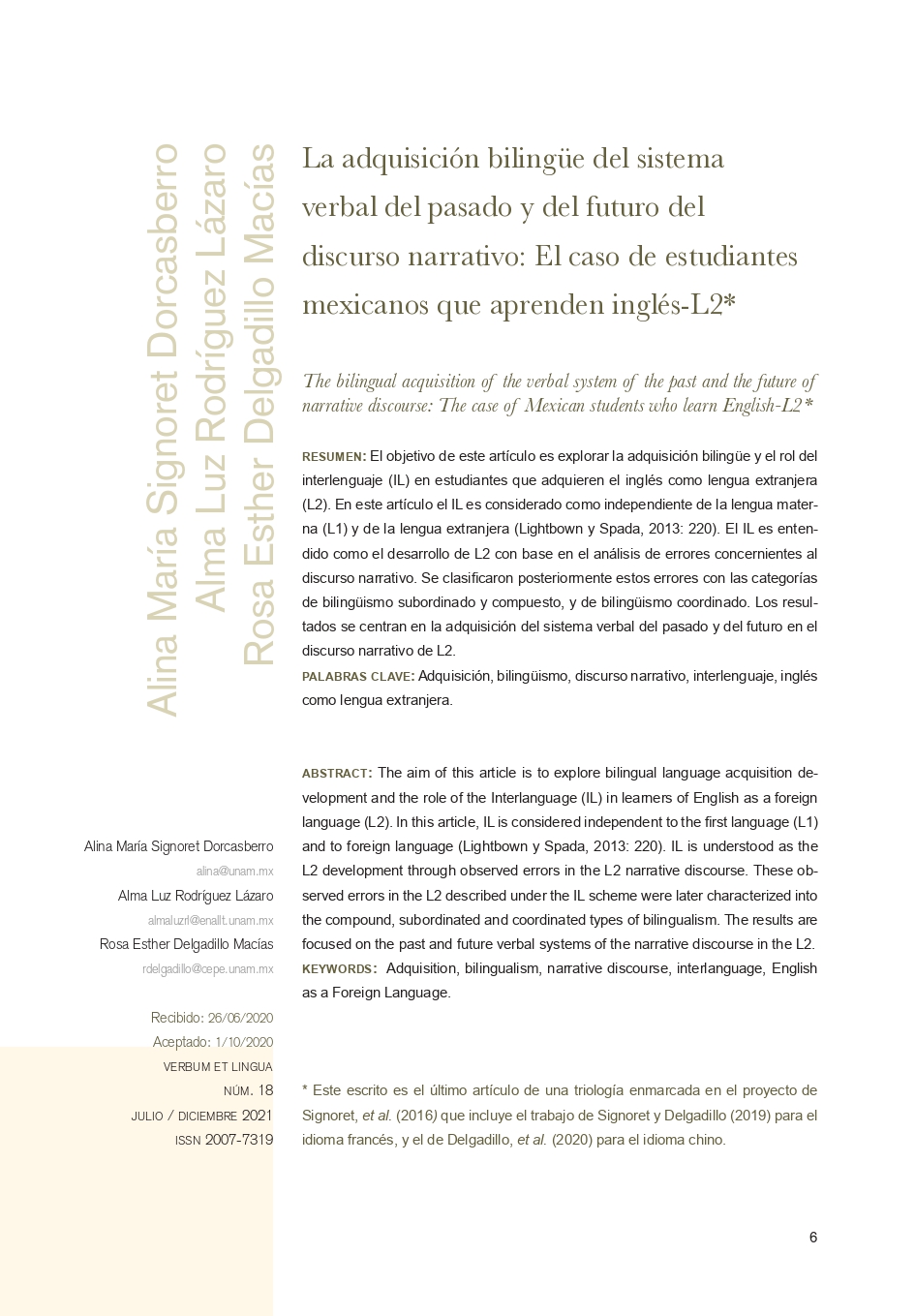La adquisición bilingüe del sistema verbal del pasado y del futuro del discurso narrativo: El caso de estudiantes mexicanos que aprenden inglés-L2*
DOI:
https://doi.org/10.32870/vel.vi18.157Parole chiave:
Adquisición, Bilingüismo, Discurso narrativo, Interlenguaje, Inglés como lengua extranjeraAbstract
El objetivo de este artículo es explorar la adquisición bilingüe y el rol del interlenguaje (IL) en estudiantes que adquieren el inglés como lengua extranjera (L2). En este artículo el IL es considerado como independiente de la lengua materna (L1) y de la lengua extranjera (Lightbown y Spada, 2013: 220). El IL es entendido como el desarrollo de L2 con base en el análisis de errores concernientes al discurso narrativo. Se clasificaron posteriormente estos errores con las categorías de bilingüismo subordinado y compuesto, y de bilingüismo coordinado. Los resultados se centran en la adquisición del sistema verbal del pasado y del futuro en el discurso narrativo de L2.
Downloads
Metriche
Riferimenti bibliografici
Alexopoulou, A. (2006) “Los criterios descriptivos y etiológicos en la clasificación de los errores del hablante no nativo: una nueva perspectiva”. En Revista Porta Linguarum. Granada: Universidad de Granada, pp. 17-35.
. (2010) “Errores intralinguales e interlinguales en la interlengua escrita de aprendientes griegos de E/LE”. En Civil, P. & F. Crémoux (2010) (Coord.): Actas del XVI Congreso de la Asociación Internacional de Hispanistas. Madrid: Iberoamericana, pp. 1-10.
Altarriba, J. y R.R. Heredia (2008) An Introduction to Bilingualism. Nueva York: Lawrence Erlbaum Associates.
Auza, A. & Zimmermann, K. (2013) ¿Qué me cuentas? México: Edicionres De Laurel. Balbino, A. (2007) La interlingua. Madrid: Arco Libros.
Balbino, A. (2007) La interlingua. Madrid: Arco Libros.
Benoit, C. (2013) Tiempos y formas verbales en la producción oral de un grupo de preescolares y escolares de primer año básico. Literatura y Lingüística, no. 28, pp. 169-192. ISSN 0716-5811.
Bialystok, E. (2009). “Bilingualism: The good, the bad, and the indifferent”. En Bilingualism: Language and Cognition, 12, 3-11.
Blin, B. (Coord.) (2013) Programa de Francés, Cuaderno 1. México: CELE – UNAM.
Cook, V. & B. Bassetti (2011) (Eds.) Language and Bilingual Cognition. Nueva York: Taylor & Francis Group.
Corder, S.P. (1967) “The significance of learner’s errors”. En IRAL, núm. 5, pp. 161-70.
Chomsky, N. (2003). On Nature and Language. Cambridge UK: Cambridge University Press.
__________. (2004). The Generative Enterprise Revisited. Nueva York: Mouton de
Gruyter.
De Groot, A. (2011) Language and Cognition in Bilinguals and Multilinguals. Nueva York: Taylor & Francis Group.
Gili Gaya, S. (1960) Funciones gramaticales en el habla infantil. Río Piedras, PR. Universidad de Puerto Rico.
_____________. (2000) Curso Superior de Sintaxis Española. Barcelona: Vox.
Grévisse, M. (1975) Le Bon Usage. París: Duculot.
Grosjean, F. (2015) Parler plusieurs langues. París: Albin Michel.
Hernández, R., Fernández, C. y Baptista, P. (2010). Metodología de la Investigación. 5ª. Ed. Colombia: McGraw-Hill.
Instituto Cervantes (2001) Marco común europeo de referencia para las lenguas. Recuperado de http://cvc.cervantes.es/ensenanza/biblioteca_ele/marco/
Karmiloff-Smith, A. (1992). Beyond modularity. Cambridge, Londres: The MIT Press.
Leslie, A.M. (1987). “Pretense and representation: The origins of “Theory of mind”. En Psychological Review 94. Pp. 412-26.
Lightbown, P. & N. Spada (2013) How Languages are Learned. Oxford: Oxford University Press.
Murphy, R. (2015). Essential Grammar in Use. (4th ed). Cambridge University Press).
Paradis, M. (2004). Neurolinguistic Theory of Bilingualism. Amsterdam: John Benjamins.
. (1987). “Bilinguisme”. En Rondal, J.A. y J-P, Thibaut (Comp.): Problèmes de Psycholinguistique. Bruxelles: Pierre Mardaga Editeur, pp. 422-89.
Parrot, M. (2000) Grammar for English Language Teachers. Cambridge: Cambridge University Press.
Piaget, J. y B., Inhelder (1982). De la lógica del niño a la lógica del adolescente. Buenos
Aires: Paidós.
Richards, J. (1971) “Error analysis and second language strategies”. En Language Sciences, vol. 17, pp. 12-22.
Signoret, A; Rodríguez, A. & R.E. Delgadillo (2016) La adquisición bilingüe del discurso
narrativo, proyecto de investigación SIDA-160809, DLA-ENALLT, UNAM.
Selinker, L. (1992) Rediscovering Interlanguage. Londres: Longman.
Siegler, R. (2000). Enfant et raisonnement. Le développement cognitif de l’enfant. Tercera Edición. De Boeck.
Van Patten, B. & A. Benati (2010) Key Terms in Second Language Acquisition. Nueva York: Continuum.
Weinreich, U. (1953) Language in contact. Findings and problems. Nueva York: Publications of the linguistic Circle of New York 1.

Downloads
Pubblicato
Versioni
- 2024-11-08 (2)
- 2022-06-21 (1)












